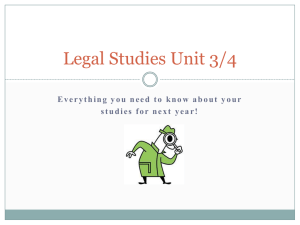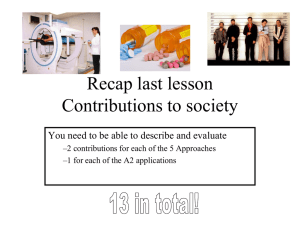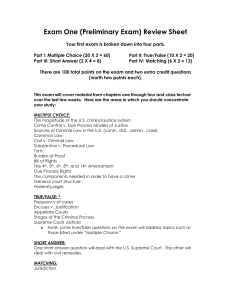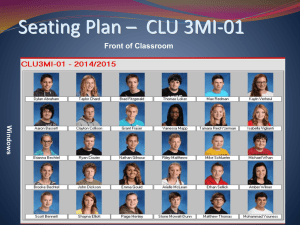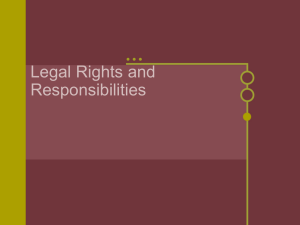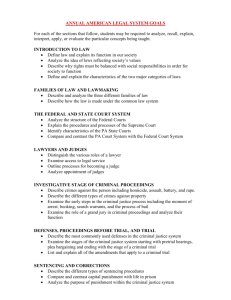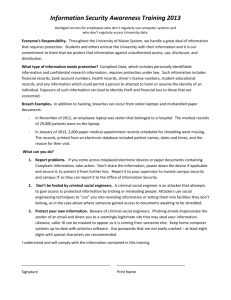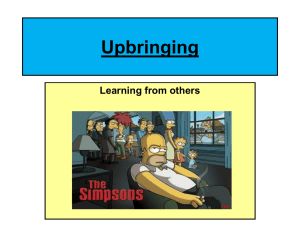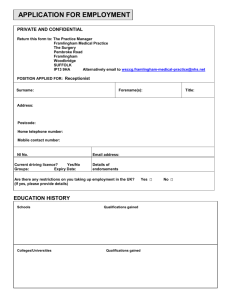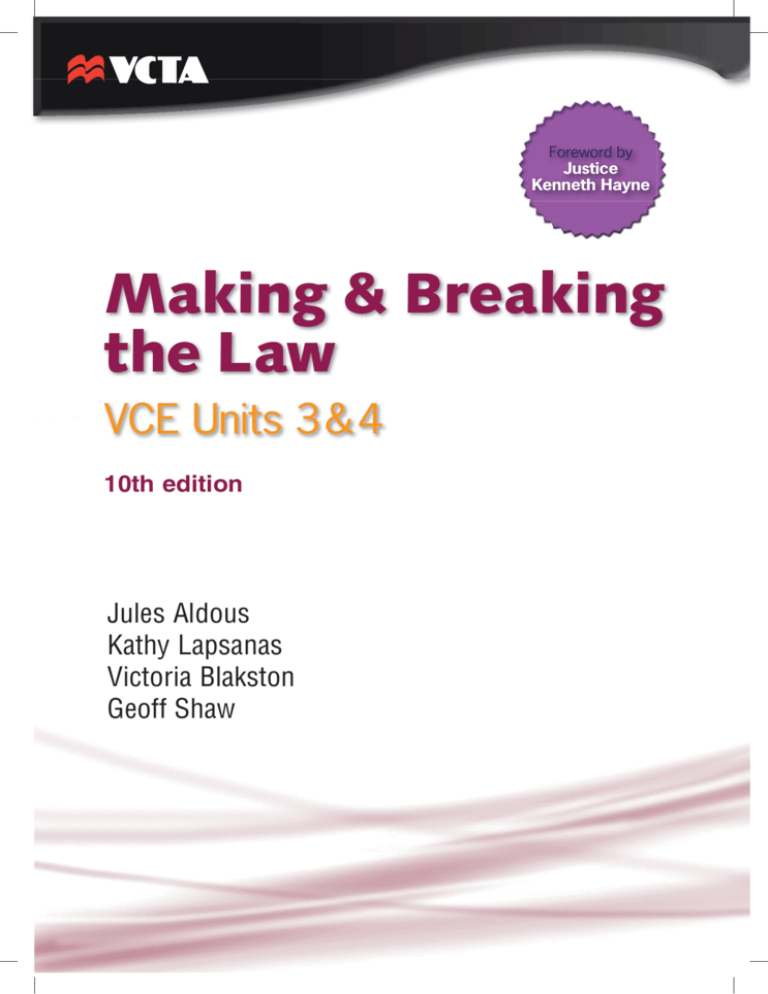
Foreword by
Justice
Kenneth Hayne
Making & Breaking
the Law
VCE Units 3 & 4
10th edition
Jules Aldous
Kathy Lapsanas
Victoria Blakston
Geoff Shaw
First edition published 1991 by VCTA Publishing
Second edition published 1993 (reprinted twice)
Third edition published 1995 (reprinted once)
Fourth edition published 1997
Fifth edition published 1999 (reprinted 3 times)
Sixth edition published 2001
Seventh edition published 2005 (reprinted once)
Eighth edition published 2008 (reprinted once)
Ninth edition published 2010 by
VCTA Publishing, an imprint of
macmillan education australia pty ltd
15–19 Claremont Street, South Yarra 3141
Visit our website at www.macmillan.com.au
Associated companies and representatives
throughout the world.
Copyright © VCTA 2013
All rights reserved.
Except under the conditions described in the
Copyright Act 1968 of Australia (the Act) and subsequent amendments,
no part of this publication may be reproduced,
stored in a retrieval system, or transmitted in any form or by any means,
electronic, mechanical, photocopying, recording or otherwise,
without the prior written permission of the copyright owner.
Educational institutions copying any part of this book
for educational purposes under the Act must be covered by a
Copyright Agency Limited (CAL) licence for educational institutions
and must have given a remuneration notice to CAL.
Licence restrictions must be adhered to. For details of the CAL licence contact:
Copyright Agency Limited, Level 15, 233 Castlereagh Street, Sydney, NSW 2000.
Telephone: (02) 9394 7600. Facsimile: (02) 9394 7601. Email: info@copyright.com.au
National Library of Australia
Cataloguing-in-Publication entry
Author: Aldous, Jules, author
Title: Making and Breaking the Law. VCE units 3 & 4 / Jules Aldous,
Kathy Lapsanas, Victoria Blakston, Geoff Shaw.
Edition:10th Edition
ISBN: 9781420232585 (pbk)
Target Audience: For secondary school age.
Subjects: Law--Study and teaching (secondary)--Australia
Law--Australia--Problems, exercises, etc.
Other Authors / Contributors: Lapsanas, Kathy, author.
Blakston, Victoria, author. Shaw, Geoff, author.
Dewey number: 349.94
Publisher: Lucinda Joura
Project editor: Liz Filleul
Editor: Carolyn Leslie
Illustrators: Paul Lennon, Guy Holt
Cover and text designer: Dimitrios Frangoulis
Photo research and permissions clearance: Jes Senbergs
Typeset in Slimbach Book, 9.5pt/11pt by Avril Makula
Cover image: Alamy/fStop
Indexer: Emma Koch
Printed in Malaysia
Internet addresses
At the time of printing, the internet addresses appearing in this book were correct. Owing to the dynamic nature of the internet,
however, we cannot guarantee that all these addresses will remain correct.
Warning
Indigenous Australian readers are advised that this publication may contain images of deceased persons.
Contents
Foreword................................................................................................................ vii
Introduction........................................................................................................... viii
Unit
Chapter
3 Law-making
C hapter
C hapter
C hapter
1
2
Law and society: an introduction
Rules and laws.......................................................................................................... 4
A legal system.......................................................................................................... 6
Types of laws............................................................................................................ 6
Why do we need laws?.............................................................................................. 9
Summary checklist................................................................................................................12
The Australian parliamentary system
14
A Westminster system............................................................................................. 16
Parliament in Australia............................................................................................ 16
Principles of the Australian parliamentary system..................................................... 18
Separation of powers............................................................................................... 19
Commonwealth Parliament...................................................................................... 22
Case file How is government formed?..............................................................................27
Victorian Parliament............................................................................................... 29
Representative government.......................................................................................31
Responsible government...........................................................................................31
Summary checklist................................................................................................................34
3
4
2
Changing the law
36
Why laws need to change........................................................................................ 38
Influencing change.................................................................................................. 44
Informal pressures for change.................................................................................. 44
Formal pressures for change.................................................................................... 57
Case file Registration of sex offenders reviewed.............................................................59
What factors hinder change?................................................................................... 62
Summary checklist................................................................................................................64
Parliament: law-making processes
66
Initiation of legislation............................................................................................ 68
Bills....................................................................................................................... 68
Drafting legislation.................................................................................................. 69
Passing an Act of Parliament.................................................................................... 73
Case file Beach ban on smoking—legislative process in action.....................................77
Delegated legislation............................................................................................... 84
Case file Delegation—efficiency, flexibility or abdication?.............................................85
Strengths and weaknesses of parliament as a law-maker........................................... 88
Summary checklist................................................................................................................91
ISBN: 978 1 4202 3258 5
iv Contents
C hapter
C hapter
Unit
5
6
Constitution: law-making powers and human rights
94
How does the Constitution divide law-making power?............................................... 96
What is a referendum?........................................................................................... 102
What is the role of the High Court?......................................................................... 110
Case file Treaties, conventions and the Constitution....................................................116
Human rights........................................................................................................122
How does the Constitution protect human rights?....................................................123
Protecting rights—comparative approaches.............................................................135
Case file United States Bill of Rights...............................................................................139
Case file Canadian Charter of Rights and Freedoms....................................................141
Case file New Zealand Bill of Rights Act.........................................................................144
Case file South African Bill of Rights...............................................................................146
Summary checklist..............................................................................................................151
The role of courts in law-making
154
What is the doctrine of precedent?..........................................................................156
How did common law develop?..............................................................................156
Precedents.............................................................................................................157
Flexibility and precedents.......................................................................................163
Case file Bank fees decision reversed.............................................................................163
Case file The chip, the slip and the trip to court............................................................164
Interpreting past decisions......................................................................................167
The ability of judges and courts to make law...........................................................169
Case file Are farmers responsible for animals that stray?..............................................170
Statutory interpretation..........................................................................................173
Case file The Chroming Case..........................................................................................173
Reasons for interpreting statutes.............................................................................176
How judges interpret legislation..............................................................................176
What effect does statutory interpretation have?........................................................179
Case file Is a studded belt a weapon?............................................................................179
The relationship between courts and parliament......................................................182
Case file What is native title?—a landmark case............................................................185
An evaluation of law-making through courts...........................................................188
Summary checklist..............................................................................................................194
4 Dispute resolution
C hapter
ISBN: 978 1 4202 3258 5
7
Dispute resolution
Types of disputes...................................................................................................202
Courts...................................................................................................................205
Reasons for a court hierarchy.................................................................................206
State courts...........................................................................................................208
Case file What do ‘specialist’ Magistrates’ Courts do?.................................................214
Tribunals...............................................................................................................223
Victorian Civil and Administrative Tribunal.............................................................223
Methods of dispute resolution.................................................................................229
Case file Mediation—increating access to dispute resolution......................................233
Evaluation of dispute resolution methods................................................................239
Dispute resolution—a comparison..........................................................................241
Summary checklist..............................................................................................................247
200
Contents v
Chapter
Chapter
C hapter
C hapter
8
9
Effectiveness of the legal system
250
What is a legal system?........................................................................................252
What is an effective legal system?.........................................................................252
Case file What is a fair trial?...........................................................................................255
Limitations on the effectiveness of the legal system...............................................262
Evaluating the legal system..................................................................................262
Summary checklist............................................................................................................265
The adversary system
10
11
268
Adversary trial model...........................................................................................270
Elements of the adversary trial............................................................................. 271
Strengths of the adversary system.........................................................................277
Weaknesses of the adversary system.....................................................................278
The inquisitorial system.......................................................................................282
A comparative analysis........................................................................................285
Effectiveness of the adversary system....................................................................288
Case file Access and costs.............................................................................................290
Case file Access, Indigenous people and evidence....................................................296
Summary checklist............................................................................................................302
Criminal procedure
306
Criminal law.......................................................................................................308
Criminal pre-trial procedures................................................................................309
Police investigation..............................................................................................309
The rights of individuals...................................................................................... 313
Case file Do we need the right to silence?..................................................................314
Bail..................................................................................................................... 316
Indictable offences............................................................................................... 319
Case file What factors will influence an offender to plead guilty?.............................324
The criminal trial.................................................................................................325
Sanctions............................................................................................................330
Evaluation of criminal procedures.........................................................................344
Case file Delays..............................................................................................................345
Case file Access to justice for Indigenous people......................................................349
Case file Access to justice and cultural differences.....................................................352
Summary checklist............................................................................................................356
Civil procedure
360
Civil actions........................................................................................................362
Deciding to take civil action.................................................................................363
Class actions.......................................................................................................366
Litigation............................................................................................................368
Hearings and procedure in civil trials....................................................................378
Mediation and arbitration.....................................................................................378
Civil remedies.....................................................................................................380
Enforcement of civil remedies...............................................................................383
Legal costs..........................................................................................................384
Evaluation of civil procedure................................................................................385
Case file Do delays limit the civil justice system?........................................................386
Case file Do costs limit the civil justice system?..........................................................390
Summary checklist............................................................................................................395
ISBN: 978 1 4202 3258 5
vi Contents
Chapter
12
The jury
Judgment of one’s peers.......................................................................................400
The jury today.....................................................................................................400
Composition and pre-selection of juries................................................................. 401
The jury trial....................................................................................................... 411
Strengths of the jury system.................................................................................416
Weaknesses of the jury system.............................................................................420
Effectiveness of the jury system............................................................................425
Reforms to the jury system...................................................................................426
Alternatives to the jury system.............................................................................428
Other changes.....................................................................................................429
Summary checklist............................................................................................................432
Glossary..............................................................................................................436
Publisher’s Acknowledgements............................................................................444
Index..................................................................................................................446
ISBN: 978 1 4202 3258 5
398
Contents vii
Foreword
The legal system is a defining characteristic of Australian society. It is the framework for
Australia’s system of government and for the organisation of our society. It forms part of
our history. It provides mechanisms for how we address the challenges of the future.
For students and practitioners of law, the mechanics of the legal system can be
difficult and complex. That is hardly surprising. The problems the legal system deals
with are difficult and complex. It is the difficulties and complexities that provide both
the law’s challenge and its fascination.
But what gives the subject its central importance, and its never-ending interest, is
that law is about society and about people. The achievements and disappointments of
the legal system record our efforts, as a society, to maintain a nation based on ideals of
justice and the rule of law.
Learning about the law and its role in society is very important to the individual
student and to society as a whole. I offer my best wishes to all students of the law.
K. M. Hayne
A Justice of the High Court of Australia
Canberra
Kenneth Hayne was appointed to the High Court of Australia in September 1997. He graduated in
Arts and Law from the University of Melbourne and as a Bachelor of Civil Law from the University
of Oxford. Elected Rhodes Scholar for Victoria in 1969, he joined the Victorian Bar in 1971 and was
appointed Queen’s Counsel for Victoria in 1984. He was appointed a judge of the Supreme Court of
Victoria in 1992. He practised in State and Federal courts principally in commercial, constitutional
and general civil matters. Justice Hayne was appointed a Companion in the General Division of the
Order of Australia in 2002.
ISBN: 978 1 4202 3258 5
viii Contents
Introduction
About this book
This icon is used to refer
you to relevant internet
resources.
Our legal system both responds to the needs and demands of the community, and
shapes relationships between individuals and groups in society. In this book, we will
explore the role of the individuals in influencing change in the law and law-making
institutions as well as the processes and institutions for enforcing the law and settling
disputes. The issues discussed, and the activities suggested, follow the requirements of
Units 3 and 4 of VCE Legal Studies.
Throughout the text exercises, essays, assignments, written reports, structured
questions and case studies have been incorporated and examples discussed. Case files
have been included to provide extended case studies and to highlight contemporary
legal issues. These case files provide teachers with flexibility in their approach to using
the text.
Case files provide:
● extended case studies as examples of issues that may be discussed in class
● case study material that may be used as the basis for assessment tasks.
Sample examination questions cover the content that may be examined at the end of
the year. Key terms have been listed at the beginning of each chapter and highlighted on
first mention in the text. Margin notes provide students with a running summary of the
key points that should be included in their revision summaries.
The internet icon refers to relevant internet sources. Students are encouraged to use
this technology in their learning and research activities.
Please note that articles in this book without a byline were written by the authors in
conjunction with a journalist.
We would appreciate your comments, and welcome your criticisms and
recommendations for future editions.
Correlation grid
A VCE correlation grid for Making and Breaking the Law is located on the
OneStopDigital website. The correlation grid links assessment tasks and page numbers
from the book to areas of study and the key knowledge requirements for the new
study design. Please view www.onestopdigital.com.au and follow the links for a free
download. Additionally, there is a free document for students that explains the outcomes
and assessment for VCE Legal Studies.
Go to the
OneStopDigital website
<www.onestopdigital.
com.au> and follow the
links to Secondary for
teacher resources.
ISBN: 978 1 4202 3258 5
Teacher resources
Additional support for teachers is also provided in the Making and Breaking the Law
Teacher Resources available at OneStopDigital (www.onestopdigital.com.au). Designed
to save you time and improve student outcomes, this resource is your complete guide to
the text. It incorporates a range of student worksheets, content summaries, crossword
puzzles, guidelines for organising mock trials, an exam revision booklet, multiple-choice
questions and answers and a list of relevant websites. The teacher resources, developed
by both beginning and experienced teachers, were created by the Head of Curriculum at
Canterbury Girls’ Secondary College and accredited De Bono trainer, Jim Ouliaris.
3
Law-making
CHAPTER1
2 Making and Breaking the Law
Law and society:
an introduction
This chapter provides an introduction to the sources of rules and laws. We will
examine the difference between legal and non-legal rules. We will also look at
the classification of laws as criminal or civil, statute or common law.
Rule systems
Types of rules
Non-legal
Norms
Legal rules
Rules
Source
Parliament
Process
Courts
Criminal
Civil
Chapter 1 Law and society: an introduction 3
Key terms
civil law
Laws regulating the behaviour of private individuals
contract
A legally enforceable agreement
criminal law
Laws concerned not only with the rights of individuals directly involved
but also with the welfare of society as a whole
judge-made law
The development of legal principles through the declaration of common
law or statutory interpretation
legal rules
Laws created by institutions within the legal system and enforced by the
legal system
legislation
An Act of Parliament or piece of delegated legislation
non-legal rules
norms
statute law
tort
Rules established within a group but not laws generally enforceable in the
community
Social expectations within social groups
Acts of Parliament
A civil wrong that amounts to an act or failure to act that infringes on the
rights of an individual; for example, negligence, trespass and nuisance
3
4 Making and Breaking the Law
Rules and laws
Law consists of rules that establish modes of behaviour and procedures. However, not all
rules are laws. As members of the community, we are subject to a range of rules, non-legal
and legal, which determine our relationship with other members of society. Not all the
rules that govern our actions have the same effect, importance or repercussions.
Non-legal rules
Rules can be legal rules
or non-legal rules.
Not all rules are legal. Groups within society have rules to set out how they interact and
to establish the rights and responsibilities of individual members. They are known as nonlegal rules and they help reduce the conflict within that particular group. These rules are
not found in the law. They are established by norms or rules.
For instance, within our families we are bound by rules of behaviour that set out the
individual rights and responsibilities of each member. In a family the rules are clearly
communicated, but not usually written. Clubs, sporting associations and schools also
require rules to function smoothly. Such rules may be more formally stated than norms
and may impose sanctions on members.
Are rules in sport laws?
The players in the Australian Football League are subject to complex rules. Should they
violate the rules of the game, the league provides for a tribunal to settle the dispute.
Players found guilty of violating a rule of the game are punished, either by being
suspended from playing in future games or by being fined. However, the rules that are
applied by the AFL to a game of football are not legal rules. Although they are binding
on all members of the league, they are not binding on the wider society. If you decide to
play football with the AFL you agree to abide by their rules. Should you not agree with
these rules, then you cannot play AFL football.
Non-legal rules apply to
a group but not to the
community as a whole.
These rules provide us with a guide to our interaction with other members of our
‘group’. The nature of the rules will alter from group to group. You cannot be made to join
a particular group, and therefore cannot be made to abide by its rules.
In many cases, rules are not formally stated or formally learnt. They are instilled in us
by conditioning and are considered norms. For example, there is no single law stating that
we must respect our parents; however, most of us do. We have learnt to behave in this
manner since we were young. The value has been instilled in us by verbal messages from
our families and perhaps by our religious beliefs.
Legal rules
Legal rules are laws
that apply to the whole
community.
ISBN: 978 1 4202 3258 5
Legal rules are known as laws. These laws set out our rights as members of the community.
For instance, Equal Opportunity legislation establishes the right of all individuals to be
treated equally. The law also establishes our responsibilities to other members of the
community or to the community as a whole. For example, laws about the use of motor
vehicles in the community impose responsibilities on all owners and drivers of motor
vehicles.
In any society it is inevitable that there will be conflicts. The law provides a means
of settling these disputes peacefully. In Australia, the law provides a range of dispute
settlement institutions and processes. For instance, courts have been established to
resolve disputes. The Victorian Civil and Administrative Tribunal (VCAT) was established
to resolve disputes between individuals. VCAT and the courts resolves disputes using a
range of dispute resolution processes. We will look at the operation of these processes in
more detail later.
Chapter 1 Law and society: an introduction 5
For laws to be established in a community, the authority of those rules must be
recognised. This recognition comes from the ability of the law to reflect the collective
needs and values of society. In Australia, the individual is encouraged to take an active role
in the development of the legal system through a number of democratic processes. These
processes include the electoral system, the provision of representative and responsible
government, and the use of the jury system.
In summary, the basic features of a law are:
l the statement of a particular type of behaviour (this usually takes the form of either
prohibiting or regulating certain types of behaviour)
l the provision of a sanction or remedy against anyone who violates the law
l the formation of the rule by an authority recognised by the community.
For example, the criminal law establishes expected behaviour by prohibiting certain
actions. The criminal law is made by parliament, which is recognised by the community
as having the authority to make the law for the community as a whole. If a person does
something that has been prohibited by the criminal law, they will be punished by either
having their liberty restricted or a fine imposed.
Sport—defining legal and non-legal rules
Some actions are only permitted within legally recognised games. For instance, the sport
of boxing is strictly regulated and recognised organisations control boxing events. In a
boxing match, punches are thrown with the intention of physical contact that may result
in harm. Outside the boxing ring these same actions would come under legal rules, in
particular the law of assault.
A boxer who agrees to take part in a legally recognised boxing match consents
to actions that would otherwise be considered assault—provided that the match is
conducted according to the rules of the sport of boxing. However, if a boxer were
to continue the fight after the end of the match, then that person would be acting
outside the rules of the sport. In this case, the boxer may be subject to the legal
rules of assault.
There can sometimes be a fine line between legal and non-legal rules. For
instance, the AFL requires all players to agree to abide by the AFL rules (non-legal
rules). However, the agreements made by professional players to play AFL football are
contractual agreements (legal rules). Sometimes conflicts may arise between how the
AFL applies rules and the principles of natural justice. In such cases, the courts may be
asked to review decisions made by the AFL Tribunal.
ISBN: 978 1 4202 3258 5
6 Making and Breaking the Law
A legal system
Legal rules differ from non-legal rules in that legal rules apply to the community as
a whole. The legal system establishes procedures and institutions to make, administer,
adjudicate and enforce the law in the community.
In our legal system, law-making is primarily the responsibility of the Commonwealth
Parliament and the state parliaments. Courts (judges and magistrates) are responsible for
interpreting the meaning of the law and resolving disputes when it is claimed that the law
has been broken (adjudicating).
A variety of bodies have been established to enforce the law. For instance, the police
have the power to impose on-the-spot fines and the Department of Justice is a government
department responsible for the administration of justice. Because our legal system is
complex, individuals may require assistance. Solicitors and barristers act as legal advisers
and representatives for individuals in their dealings with the legal system.
Types of laws
Laws can be classified
according to the source
or the type of behaviour
regulated.
ISBN: 978 1 4202 3258 5
The types of laws that we have in our society can be classified in a number of different
ways. Whatever method we use to classify the law it is necessary to remember that, in
a developed society such as ours, the law is complex and constantly changing. New
areas of law develop that may not neatly fit into existing categories. No one method of
classification can cover all aspects of our law.
By looking at the different ways of classifying the law we can start to appreciate the
complexity of our legal system. The methods used to classify our laws include:
l statute or common law (sources of law)
l criminal or civil law (type of behaviour).
The method that we choose to classify the law will reflect the purpose for which the
classification is needed. For example, in Unit 3 we look at the law-making process. For the
purpose of our study in this section we might want to
classify the law according to the different processes
used to make the law (or sources of law). In Unit 4 we
look at dispute settlement processes and procedures,
and so may want to classify the law according to
the different processes used to resolve disputes. The
dispute settlement processes and procedures differ
according to whether they are for criminal or civil
cases (or according to type of behaviour).
In some cases, a wrongful act may involve more
than one area of law. It may involve both the rights
of individuals, and the relationship between the
individual and the state.
This is often the case in car accidents. For
instance, a speeding driver who fails to stop at a red
light is guilty of a criminal offence. This behaviour
constitutes a danger to the community as a whole.
While driving through the red light the driver collides
with another car. As a result of the collision, the
second car has been damaged. The rights of the
owner of the second car have been infringed. The
driver of the second car could recover this loss
through the civil law by suing the other driver.
Chapter 1 Law and society: an introduction 7
1.1 Sources of law
Source
Judge-made
Parliament
Common law
and statutory
interpretation
Statutes,
legislation, Acts
Subordinate bodies
Regulations,
orders-in-council,
local laws
Statute or common law
Two sources of law are
parliament and the
courts.
There are two sources of law in Australia.
l Parliaments are responsible for making statute law. Statute law is also referred to as
legislation or ‘Acts of Parliament’. Parliaments may also delegate their law-making
powers to other bodies, known as ‘subordinate authorities’. The rules made by these
bodies are known as ‘regulations’, ‘orders-in-council’ and ‘local laws’.
l Courts also have responsibility for the development of the law, either through the
process of interpreting the meaning of statutes as they apply to individual cases or
through the declaration of common law. This is sometimes known as judge-made
law.
We will discuss these two sources of law in more detail in the following chapters.
Criminal or civil law
Behaviour can be
classified as either
criminal or civil.
Laws can be classified as either criminal or civil. Criminal law is concerned with behaviour
that affects not only the individuals directly involved but also the welfare of society as a
whole. The criminal law aims to regulate the behaviour of individuals as members of the
community and to protect the interests of society. Civil law is concerned with behaviour
between one individual and another individual. This area of law includes contract law
and the law of torts.
Types of criminal laws
Criminal law is generally concerned with behaviour that is disruptive to the society as a
whole. Some of the different types of criminal offences are set out in the following table.
1.2 Types of crimes
Offences against the person
Offences relating to action that results in some form of personal injury, such
as murder, assault, rape or kidnapping
Offences against property
Offences involving conduct that results in damage to or loss of property,
such as theft or acts of vandalism
Offences against morality
Offences concerned with maintaining certain values in our society, including
incest, street prostitution and bigamy
Offences against the legal system
Offences regarding our responsibility to participate as responsible citizens in
the administration of justice—they include offences such as perjury or failure
to appear for jury service
ISBN: 978 1 4202 3258 5
8 Making and Breaking the Law
Types of civil laws
Civil law includes both contract law and the law of torts. Contract law is concerned with
legally enforceable agreements made between individuals. Torts are concerned with the
wrongful actions of one individual against another individual. Some of the different types
of torts are set out in the following table.
1.3 Types of torts
Negligence
Where the actions of an individual who has failed to exercise reasonable care adversely
affect another individual
Nuisance
Where an individual interferes with another’s enjoyment of their rights
Defamation
Where an individual damages the good name or reputation of another through false or
misleading statements
Trespass
Where an individual physically interferes with another person, their goods or land
Criminal law and civil
law are dealt with using
different procedures.
It is important to understand the difference between the two types of behaviour.
Criminal law and civil law are dealt with by different procedures and have different
consequences for the individuals involved. Criminal law is enforced by the police, the
courts and the departments of corrective services. An individual who has been charged
with a criminal offence will be prosecuted by the state and, if found guilty of an offence
by a court, will be sanctioned. A sanction may include a fine, a community correction
order or imprisonment.
Civil law is concerned with the enforcement of an individual’s rights. In civil law, the
individual affected by a breach of their legal rights is responsible for taking the case to
court. If their case is successful, the court may award monetary compensation or issue a
court order to stop any further infringement.
We look in more detail at the difference between criminal and civil law in Unit 4.
Drug addict doctor infects patients
A Melbourne anaesthetist, Dr James Latham
Peters, 63, was sentenced to 14 years’ prison with a minimum
of 10 years before parole. He had pleaded guilty to 55 charges
of negligently causing serious injury. It was alleged that the
former anaesthetist infected patients with hepatitis C at the
Croydon Day Surgery between 2008 and 2009.
Since 1996, Peters had been addicted to an opioid used in
general anaesthesia: the drug fentanyl. At Peters’ committal
hearing, the prosecution claimed that Peters would use
pre-filled syringes of fentanyl, that were intended to be
administered to patients before surgery, to inject himself with
partial doses. He would then return the syringe to general
stocks to be used on patients.
Peters had known that he had hepatitis C since 1997,
although he had not informed the clinic. Furthermore, Peters
was known to have had a drug problem at the time that the
alleged infection of the patients took place. Strict conditions
had been imposed on his access to drugs.
Fifty former patients have initiated a civil action against
the Australian Health Practitioner Regulation Authority—the
ISBN: 978 1 4202 3258 5
successor at law to the former Medical Practitioners Board of
Victoria—Dr Peters and the director of the former Croydon
Day Surgery, Dr Mark Schulberg.
In May 2012, the law firm Slater & Gordon issued a Supreme
Court class action. The class action is seeking unspecified
compensation for pain and suffering, medical expenses and
loss of income. It alleges that all three defendants breached
their duty of care to the women who underwent procedures
at the clinic. As a result of those breaches of care the women
have become infected with hepatitis C.
Slater & Gordon practice group leader Julie Clayton said,
‘This has been a distressing and traumatic event for all of the
women involved. They
put their faith in the
medical profession and
they feel betrayed at a
time when they were
most vulnerable.’
Dr James Peters
Chapter 1 Law and society: an introduction 9
Why do we need laws?
The main function of law is to enable individuals to live peacefully together. Laws
allow individuals to work cooperatively towards meeting their needs for the benefit of
all members of the community. This is a concept known as social cohesion. The term
‘cohesion’ means the act of uniting or sticking together. Laws aim to ‘unite’ or ‘stick’
society together.
To achieve social cohesion the law needs to be recognised or acknowledged by the
community. The community will recognise the authority of the law if it:
l sets out the expected behaviour of individual members
l provides a means by which disputes can be resolved
l reflects the values of the majority of the community
l provides a means for changing the law.
Establishing expected behaviour
We need laws to
establish expected
behaviour.
The law helps keep society together by prohibiting conduct that is disruptive. Prohibitions
include laws about aggressive behaviour, the use of property and the use of roads. These
matters are all regulated by the criminal law. To ensure that members of society abide by
its rules, society imposes punishments (sanctions) on those who violate them. We look at
this in more detail in chapter 10.
The rights of individuals are contained in the civil law. For example, the tort of
negligence protects the rights of individuals to be free from harm that may result from the
careless actions of another. Where the rights of individuals have been violated, the law
provides for a range of remedies to restore the individual to their original position.
There is an array of remedies, because monetary compensation is not appropriate
in all circumstances. For example, the law provides for court injunctions or orders that
require an individual to behave in a prescribed manner. Remedies provided in civil cases
are examined in more detail in chapter 11.
By stating the rights and responsibilities of individuals and society, the law makes
explicit the boundaries of behaviour. Therefore, each individual can know what is
expected and how to plan their interactions with other members of society.
Resolving disputes
We need laws to resolve
disputes.
The law is necessary to provide for peaceful dispute resolution. Life in society would
be impossible if each individual was free to resolve a dispute by any method. The law
establishes a range of dispute settlement bodies to deal with the variety of disputes that
may arise in the community. These dispute settlement bodies include courts and tribunals.
We will look at the role and function of courts and tribunals in chapter 6.
The law also provides methods that can be used to resolve disputes. They include:
l methods of dispute resolution (chapter 7)
l the adversary trial (chapter 9)
l the jury system (chapter 12).
Reflecting values
We need laws that reflect
the shared values of the
community.
One common element in all legal systems is the reliance of law on a set of values that are
shared by that society. These values are a collection of beliefs and attitudes about what
is right or good. The values that are shared by the community form the basis of what is
right or good in law.
Throughout the world, religious beliefs have strongly influenced the development
of law. Australia is a diverse community consisting of numerous religious, cultural and
ethnic groups that uphold a variety of values. However, there are some values that are
common. For example, the value that we place on human life is upheld by the majority
of people in our community. The law upholds this value by making it an offence to take
ISBN: 978 1 4202 3258 5
10 Making and Breaking the Law
another person’s life (the offence of murder). The law also recognises that there are
some circumstances in which it may be excusable to take another’s life. The right of each
individual to use reasonable force for self-protection is recognised by the laws relating to
self-defence.
It is difficult for the law to preserve the values of all members of society. In order for
us to live together as a group, it is necessary for the law to uphold the values that are
predominant. For example, the rules on marriage may vary from one religion to another.
However, the law recognises the prevailing value that marriage is the union of one man
and one woman. In Australia, only monogamous, heterosexual marriages are legally
binding. This does not necessarily reflect the values of all groups and individuals in
society. Many people strongly disagree with the idea that marriage can exist only between
one man and one woman and have called for the law to change.
The law reflects a variety of values:
l the way in which members of society relate to others (social values)
l the fundamental beliefs about right and wrong (moral values)
l the rights of individuals in the economic system (economic values)
l the rights of individuals in the organisation of our legal system (political values).
How a country interprets these values will vary according to historical, religious and
cultural influences.
Aboriginal law and values
In September 2010, a talented footballer, 21-year-old
Kwementyaye Watson, was fatally stabbed in an Alice Springs
town camp. Three Warlpiri men were charged over the death.
Only one of the men was sentenced. He was given six years in
jail for manslaughter.
In November 2010, several Watson family members were
jailed after an attempted spearing of Alistair Turner in the
leg, in a traditional payback for the death of Kwementyaye
Watson.
Watson’s football team, the Yuendumu Magpies, had not
played a game in over 18 months. The dispute between groups
within the Yuendumu community, 300km west of Alice
Springs, resulted in violent confrontations.
In May 2012, the ongoing dispute between the families
flared up again. A group of between 50 and 70 people were
involved. A man and a woman were attacked outside the
community’s health clinic. When police tried to intervene
they were pelted with rocks. Superintendent Peter Gordon
said ‘He’s got massive head injuries—it looks like he’s been
scalped, the skin has detached from the scalp’. The man was
Alistair Turner.
Traditional law forms a part of the complex rules that
govern the rights and responsibilities of Indigenous people
in Australia. The Aboriginal system of law—customary
or traditional law—contains some sophisticated elements
that reflect the cultural tradition of Indigenous people. For
instance, this system allows informality in dispute settlement,
conciliation procedures and participation in the administration
of justice, and stresses the rehabilitation of offenders.
Such dispute settlement methods are still evolving in more
developed legal systems. Although European contact has
ISBN: 978 1 4202 3258 5
lessened their influence in many regions, some Indigenous
groups in isolated areas still follow the traditional way of life.
Aboriginal law is both sacred and secular. Sacred law
is considered the more important and involves many secret
rites. Sacred law is linked to the Aboriginal concept of the
Dreamtime, and many aspects of this have not been revealed
to non-Aboriginal people. Secular law contains the body of
rules with which members of an Indigenous community are
expected to comply.
Traditional Indigenous groups have their lawmen who are
responsible for the interpretation of the sacred law. Sacred
law also imposes additional sanctions in matters such as theft,
assault and adultery. Substantial authority rests with the elders
of the community, and leadership is vested with a council of
elders. The Pitjantjatjara are one such community, consisting
of about 4000 people spread over the Northern Territory,
Western Australia and South Australia. They believe that the
law has always existed and will exist until the end of time.
The strength of the Aboriginal legal system can be seen by
the fact that it has bound a people together and maintained a
stable lifestyle for more than 40 000 years.
Chapter 1 Law and society: an introduction 11
French secularism says no to hijab
A law banning the wearing of face-covering headgear,
including masks, helmets, balaclava, hijab and other veils
covering the face in public places (except under specified
circumstance) was introduced in France in 2011. These laws
were introduced because the face coverings prevent the clear
identification of people. Those breaking this law face a fine
and/or citizenship education.
A ban on Islamic headscarves (known as hijabs) in
France’s public schools was adopted in the 2003–04 school
year. Then President Jacques Chirac said such a law was
needed to protect the French principle of secularism. The
French believe that secularism, or the separation of church
and state, is the cornerstone of the modern French state. So
important is this principle that it is guaranteed by the French
Constitution (Article 1):
France shall be an indivisible, secular, democratic and social
Republic. It shall ensure the equality of all citizens before the
law, without distinction of origin, race or religion. It shall
respect all beliefs.
Given that the Constitution also guarantees respect for all
beliefs, it may be surprising to discover that France banned
the wearing of religious apparel and signs that ‘conspicuously
show’ a student’s religious affiliation. Jewish caps (known
as kippa) and large Christian crosses would also be banned.
However, the law is more directly aimed at removing Islamic
hijabs from classrooms in state-run public schools. The
Council of State, France’s highest administrative body, said
hijabs should be banned only when they are of an ‘ostentatious
character’. The final judgment of when a hijab is ‘ostentatious
in character’ is left to the school.
The same rules apply to the kippa and Christian crucifix.
But there have been no reported cases where schools have
questioned the wearing of kippa or ‘ostentatious’ crosses.
Each year, there are about 150 complaints involving hijabs.
These complaints are heard by mediators and, if unresolved,
can lead to expulsion. These laws do not apply to private
schools.
This approach to defining secularism in France is not new.
Since 1905, France has enforced a legal separation of church
and state. A century ago, in the name of secularism, France
removed crucifixes hanging in its classrooms. Crosses were
even forbidden on coffins during funeral processions. The
removal of crucifixes was seen as necessary to symbolise the
separation of the state from the Roman Catholic Church.
There has been growing concern in France over other
demands seen to challenge the notion of the secular state.
Muslim groups have been seeking segregated classrooms for
boys and girls and the recognition of Muslim holy days in
school calendars, and some students have refused to take oral
exams with examiners of the opposite sex.
How the law defines religious freedoms within a secular
state is an issue faced in many democracies. In 2004, the state
government in Berlin proposed a law banning all religious
symbols, including the kippa and crucifix, from jobs in the
public sector. Other German states passed similar laws. In 2011
Belgium banned the full face veil. In 1981 Tunisia banned
the hijab. Turkey imposed a ban in 1997. By comparison
Syria lifted a ban on teachers wearing the Islamic veil in
2011. In Great Britain and Sweden, there is a value placed on
multiculturalism rather than assimilation. This is similar to the
approach taken in Australia. Teachers and students can wear
the hijab, kippa or crucifix. In Australia, public servants who
are Muslim are free to wear their headscarves.
Providing for change
The legal system
provides a way to change
the law.
The law must be able to provide for the changing needs of the community. To do this the
legal system provides ways in which the law may be changed. We look at the role of lawmaking bodies in Unit 3. In chapter 4 we look at the ways in which individuals, groups
and institutions in the community can influence the law-making process.
ISBN: 978 1 4202 3258 5
12 Making and Breaking the Law
Summary checklist
Do your notes cover all the following points?
l Individuals living in the community may be bound by a range of rule systems.
Generally these systems can be classified as either:
– legal rules—laws
– non-legal rules—rules of games, associations, organisations, churches and
other institutions, or the norms of behaviour.
l Legal rules differ from non-legal rules because:
– legal rules apply throughout the community
– legal rules are made by parliaments and courts
– legal rules are enforceable by courts and tribunals.
l There is a number of ways in which we can classify the different types of laws. For
our purposes, the two main ways of classifying the law are:
– criminal law and civil law
– statute law and case law.
Revision questions
1
2
3
4
5
6
Describe the different ways in which laws may be classified.
What is the difference between statute law and common law?
What type of behaviour is regulated by criminal law?
What type of behaviour is regulated by civil law?
Outline the differences between criminal law and civil law.
Describe and explain the significant features of a legal system. Could the legal system
operate without one of these features?
7 Write a paragraph outlining the key differences between the legal system and a rule
system.
8 Suggest ways in which the features of the legal system provide for:
– the resolution of conflict in the community
– participation by individuals
– the establishment of rights and responsibilities.
9 What does the term ‘social cohesion’ mean?
10 The law recognises and upholds moral, social, economic and political values. Explain
how the law achieves this by using examples.
Current issues folio
The law is constantly changing; to stay up to date you need to follow current events in
newspapers and journals, or on television or the internet. The key to maintaining a current
issues folio is organisation.
Keep your articles in a document wallet or a plastic pocket in your folder. Annotate each
article. This may be done on a separate piece of paper stapled or clipped to the article.
The annotation should include the following points:
l the source and date of the article
l a heading identifying the key legal issue discussed
l a brief summary of the issue
l notes on the relevant legal questions raised.
ISBN: 978 1 4202 3258 5
Chapter 1 Law and society: an introduction 13
M & B Review
Saw red over purple stamp
A man claimed that he stabbed his sister when an argument broke out because her pet guinea pig
ate part of his stamp collection. The defendant claimed that when he saw his 1904 6-penny purple
KEVII stamp in the guinea pig’s mouth ‘he just saw red’. He started yelling at his sister and, in
the course of the argument, picked up a kitchen knife and struck her.
The man pleaded guilty in the Magistrates’ Court to one charge of recklessly causing injury.
He was given three months’ prison, wholly suspended for six months.
After the case his sister said, ‘A suspended sentence, it’s like he didn’t get anything. It has
trivialised my experience’.
31 February 2018
M & B Review 31/2/18
Source
Sentencing
Issue
Prosecution for recklessly causing injury
Indictable offence heard summarily
Are suspended sentences effective?
Legal question
l
l
l
l
Make a start on your issues folio with the following exercise.
Collect two articles illustrating aspects of criminal law.
Collect two articles illustrating aspects of civil law.
Collect two articles discussing proposed changes to statute law.
Collect one article discussing an aspect of judge-made law.
Annotate your articles—as illustrated in the example above.
ISBN: 978 1 4202 3258 5

